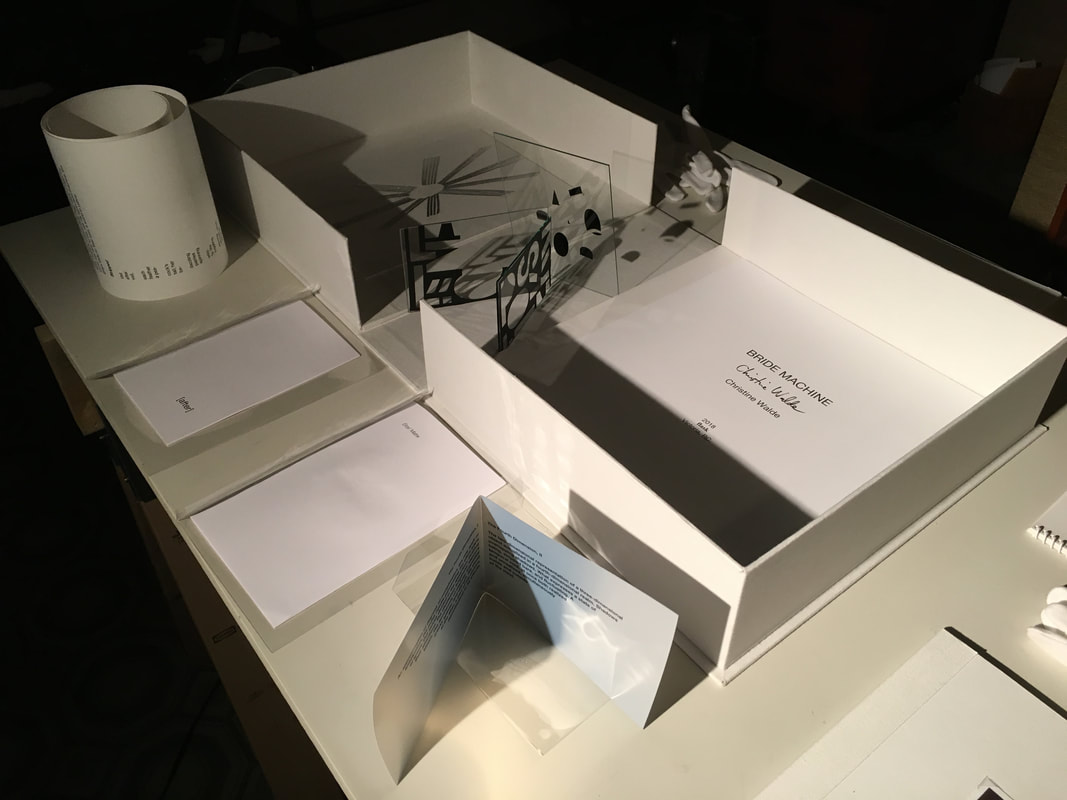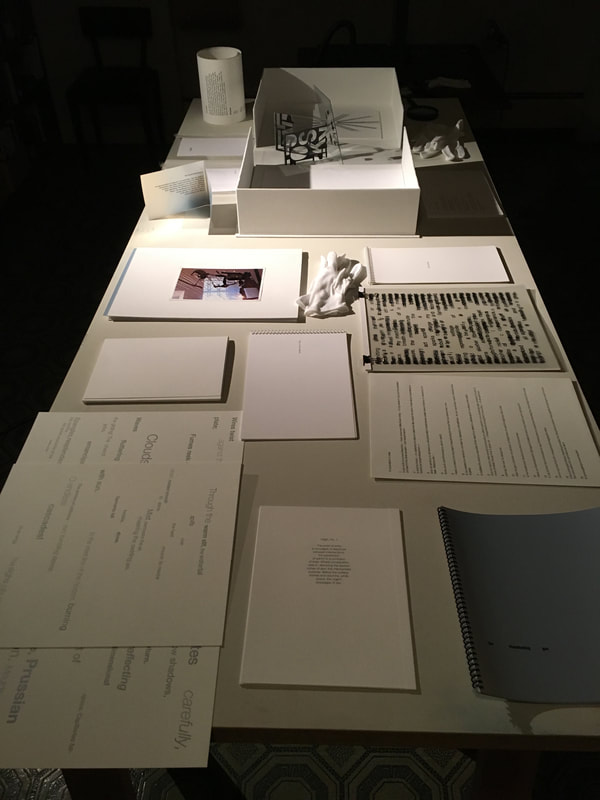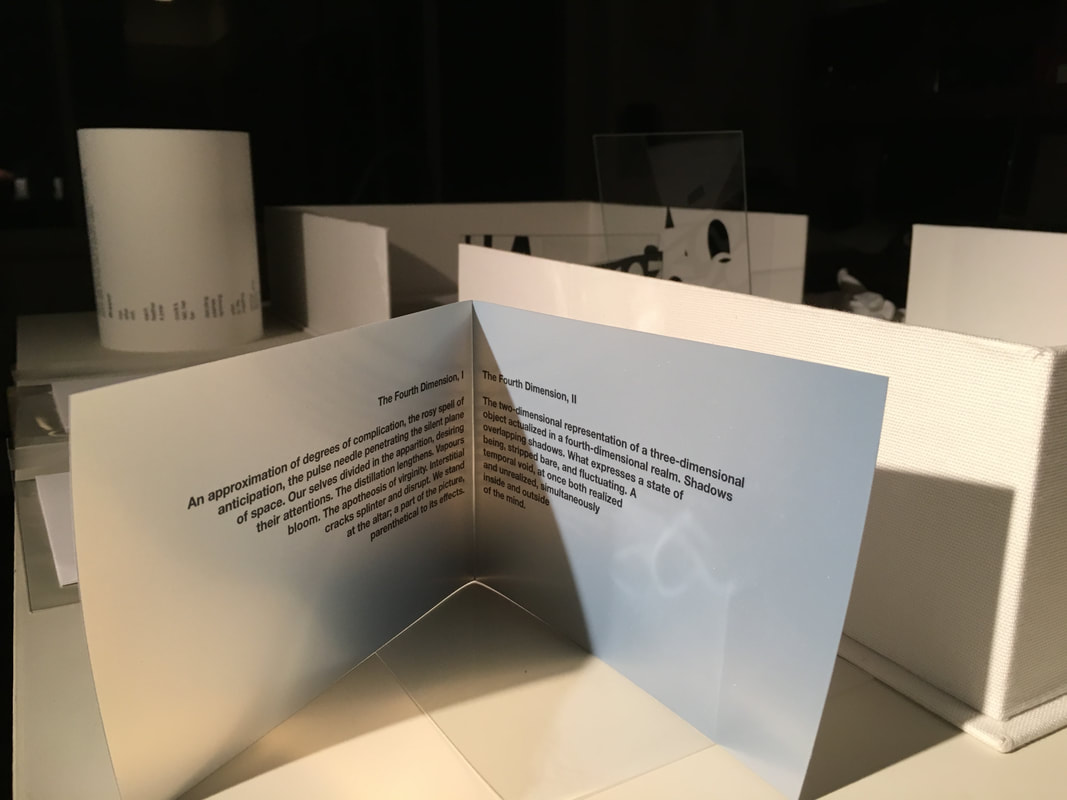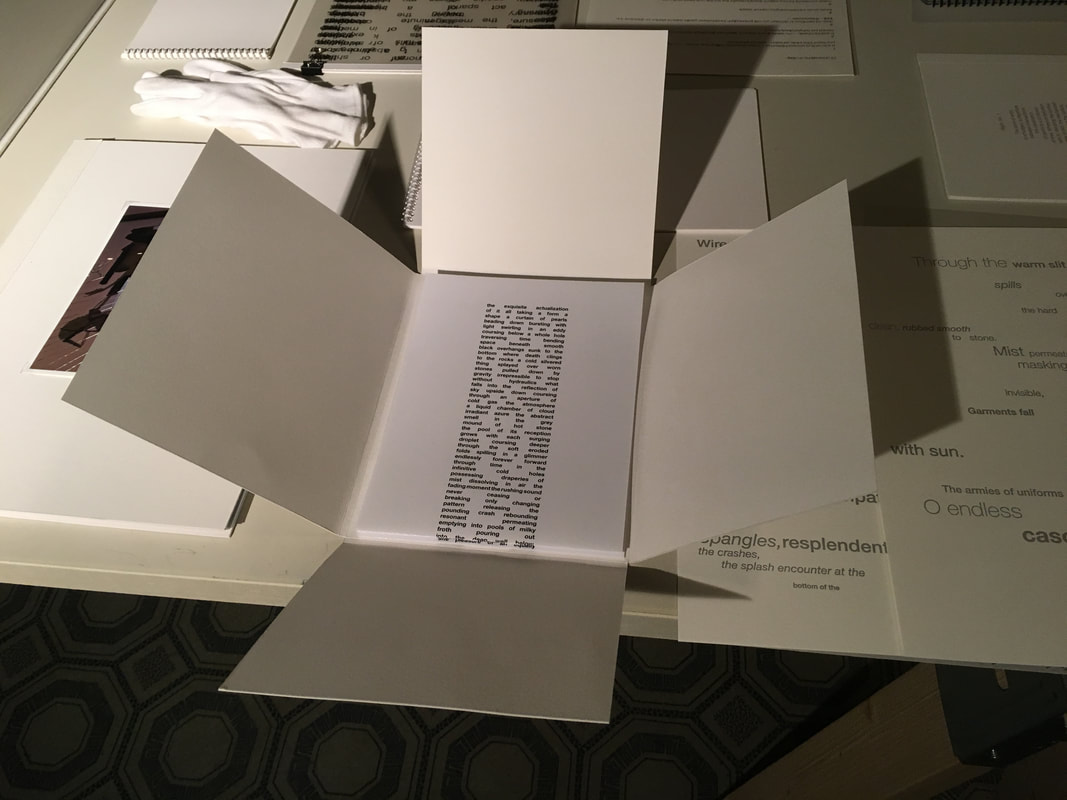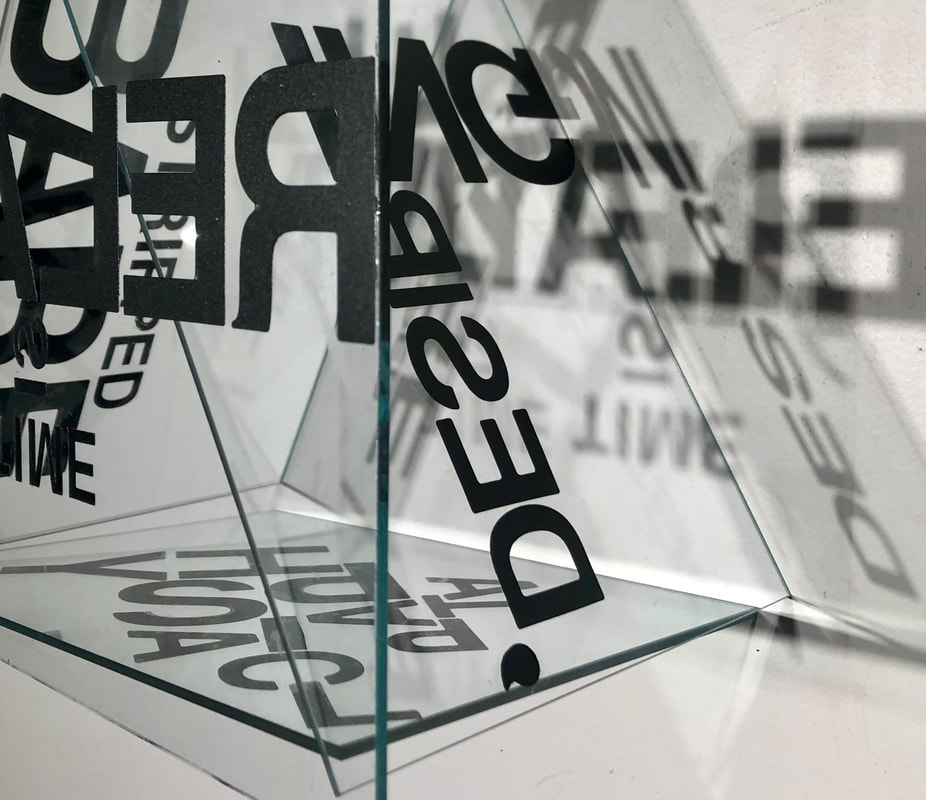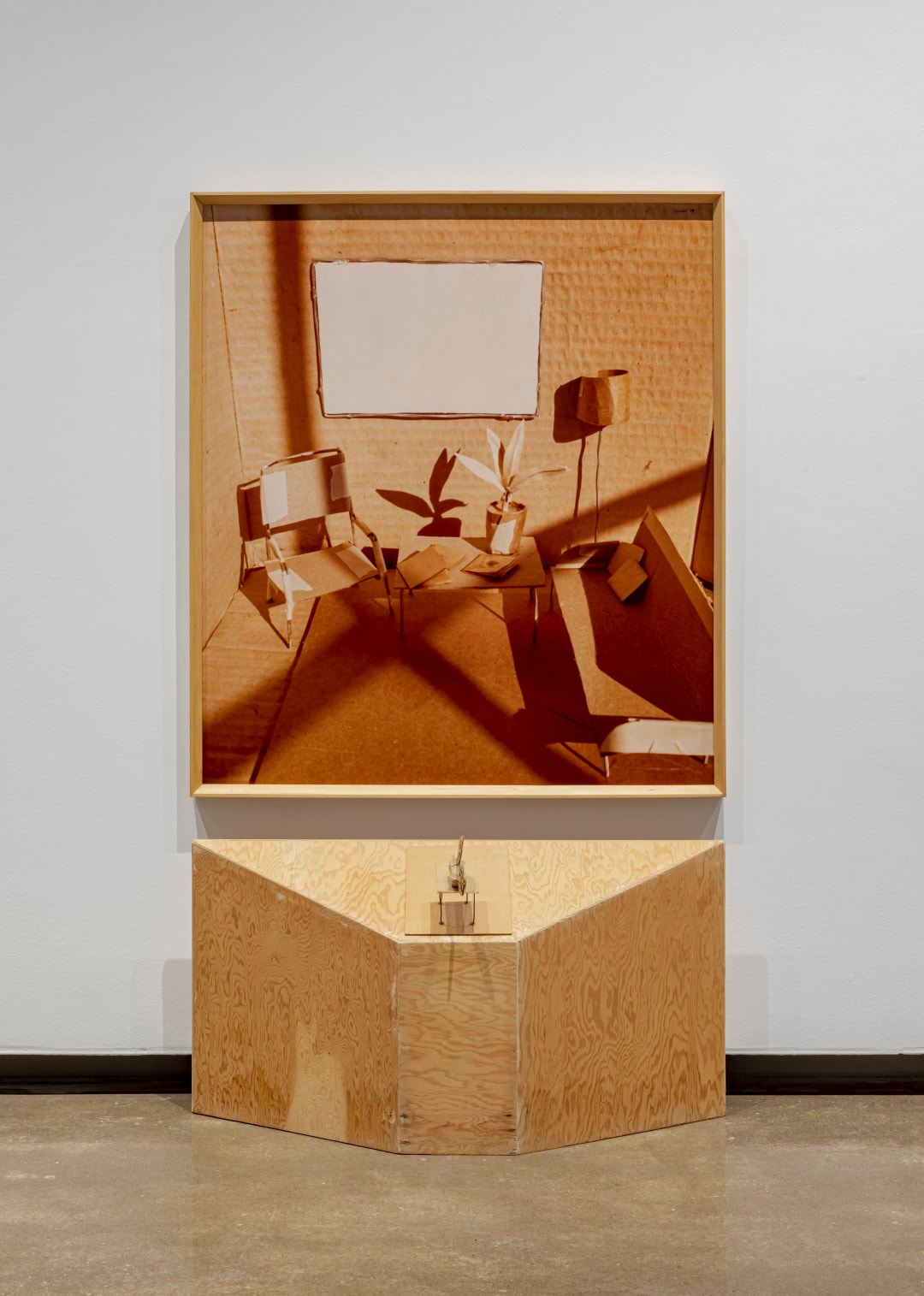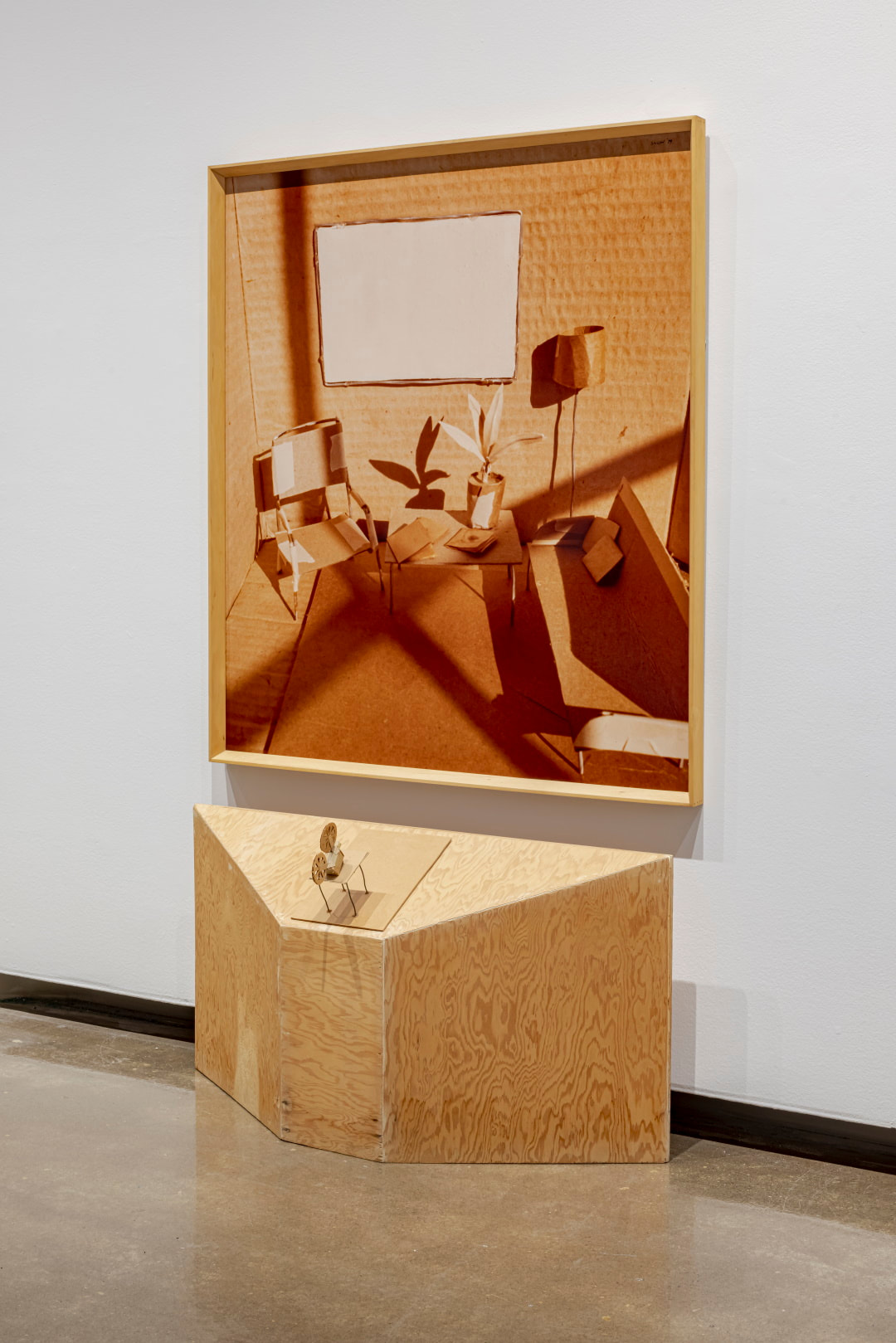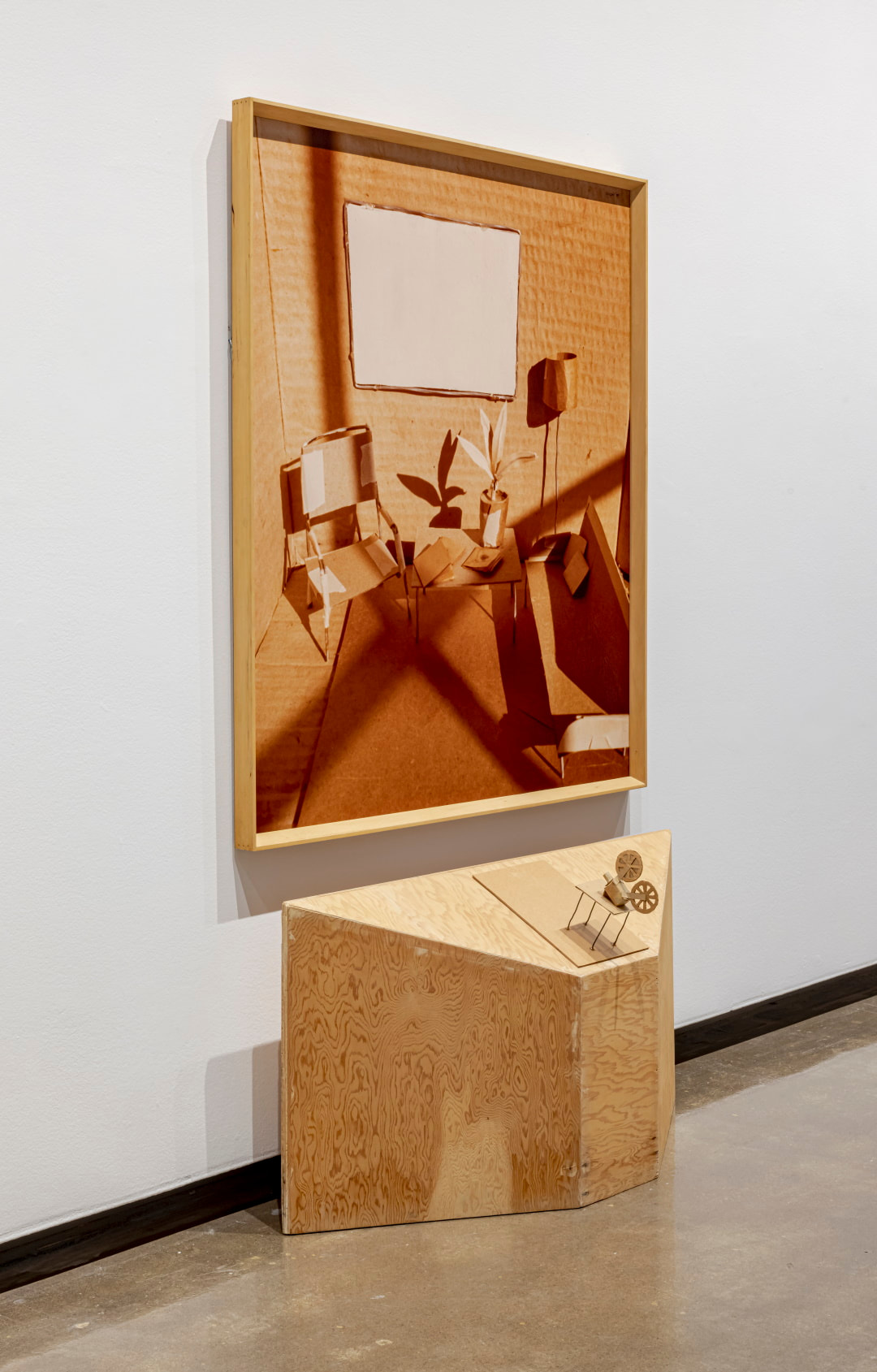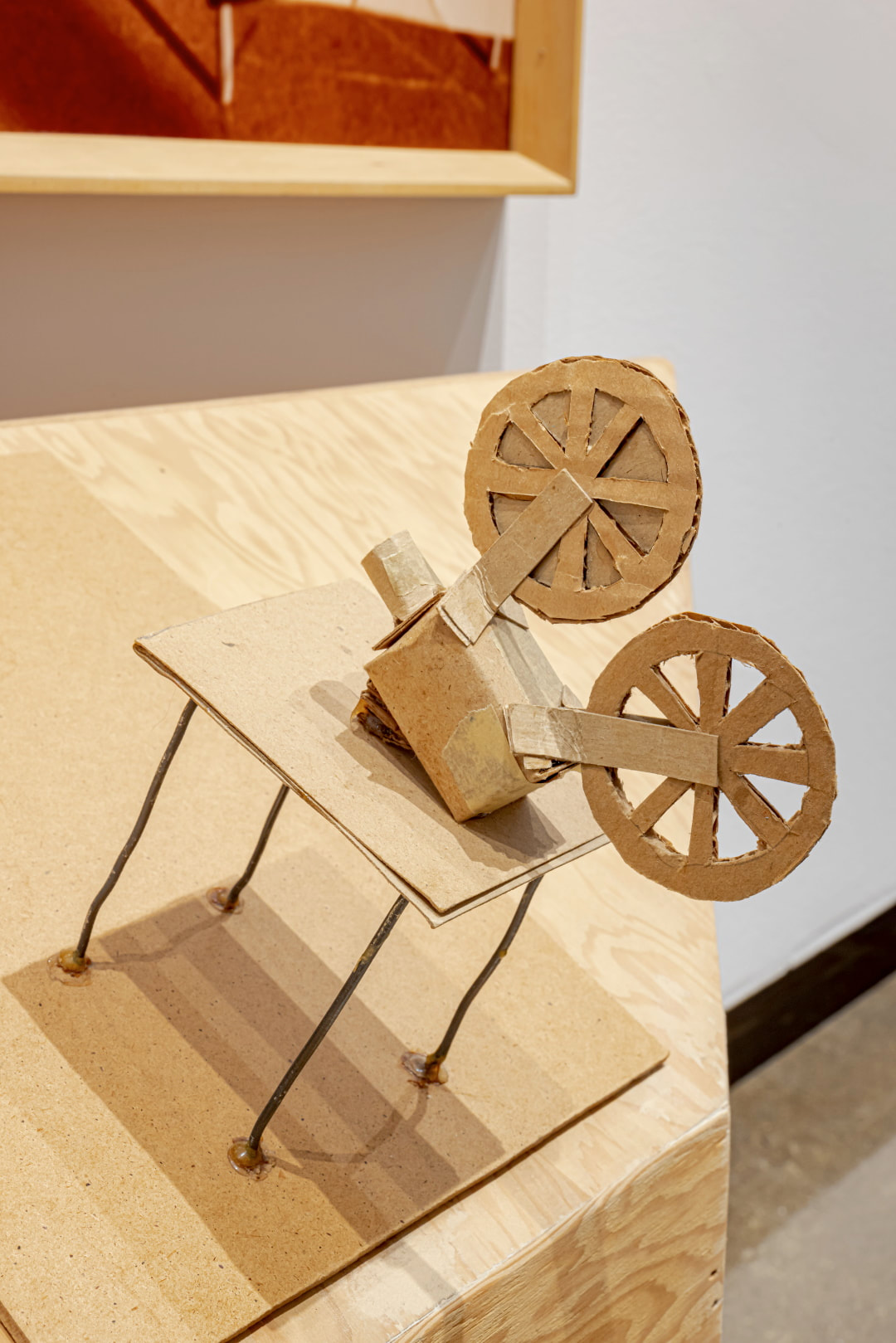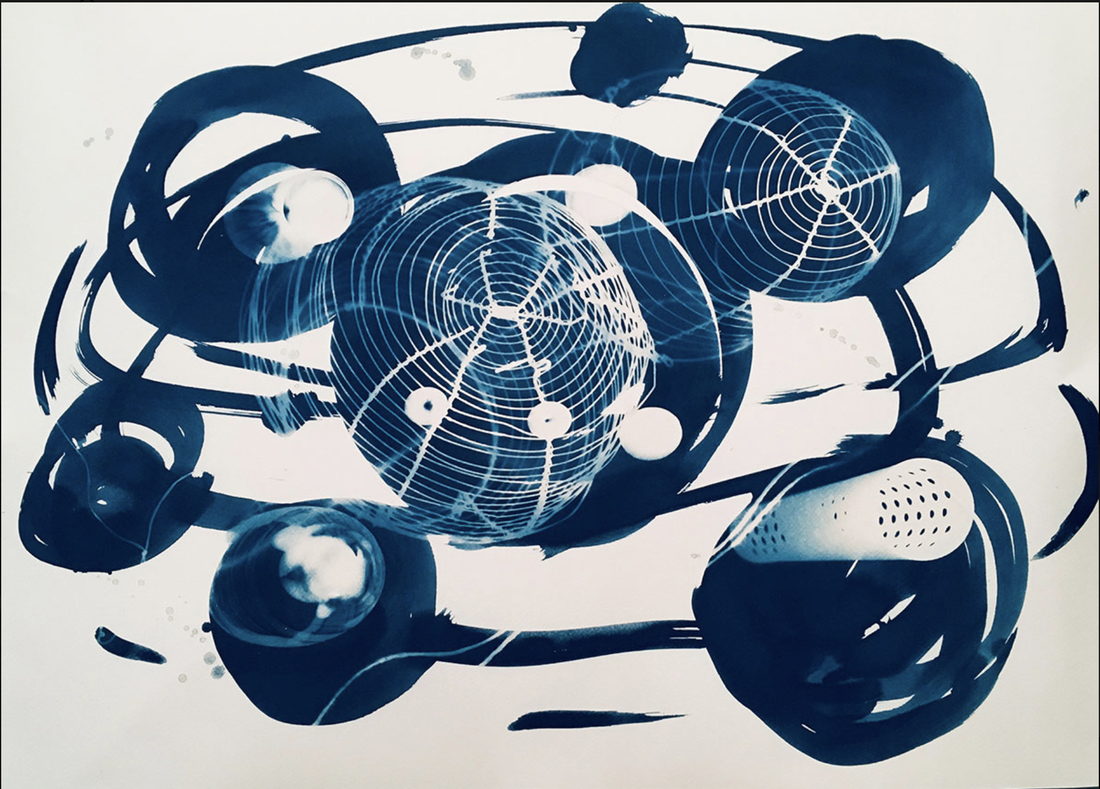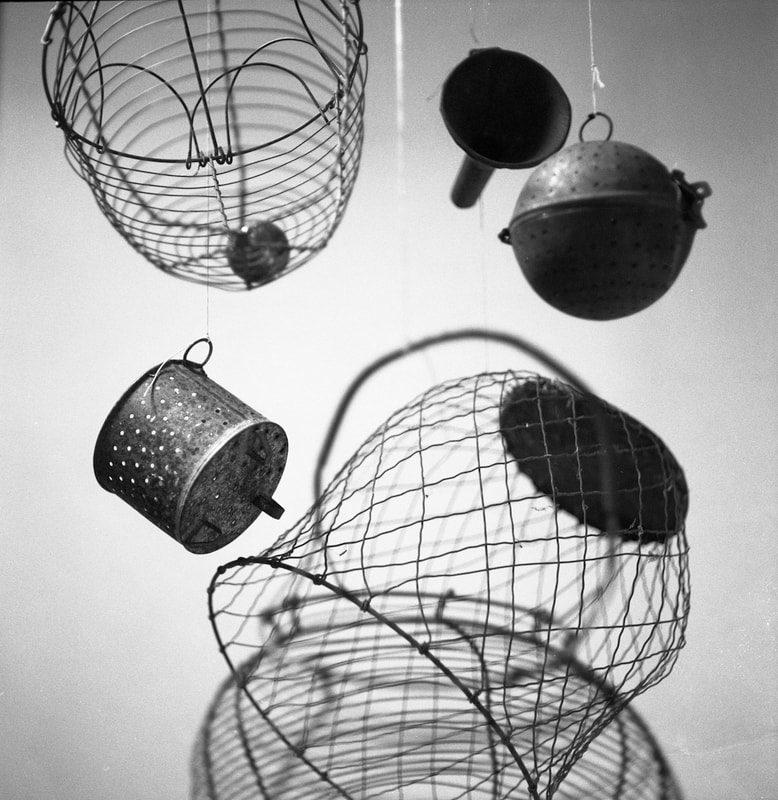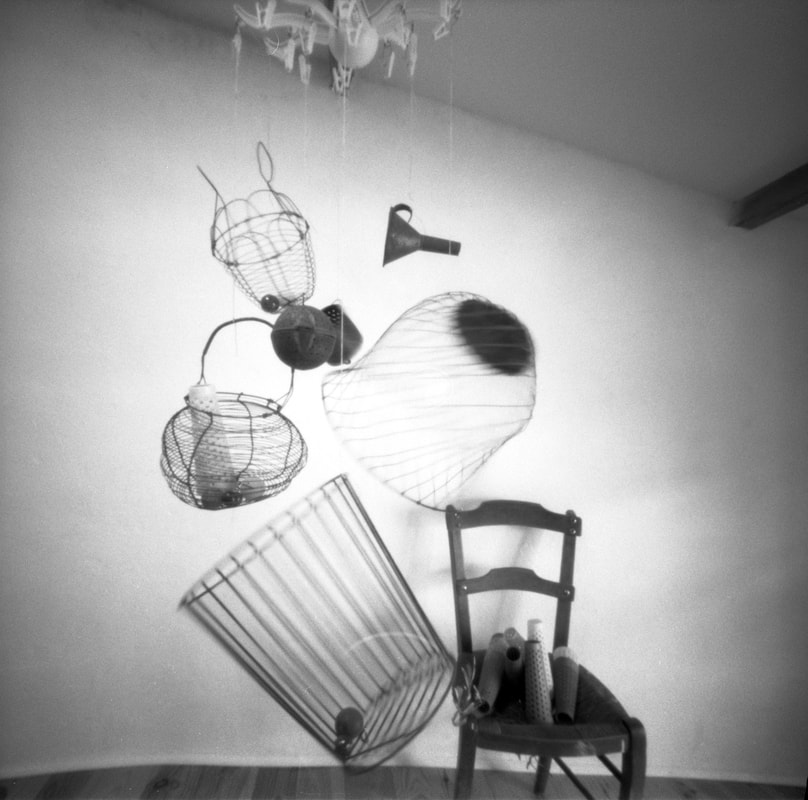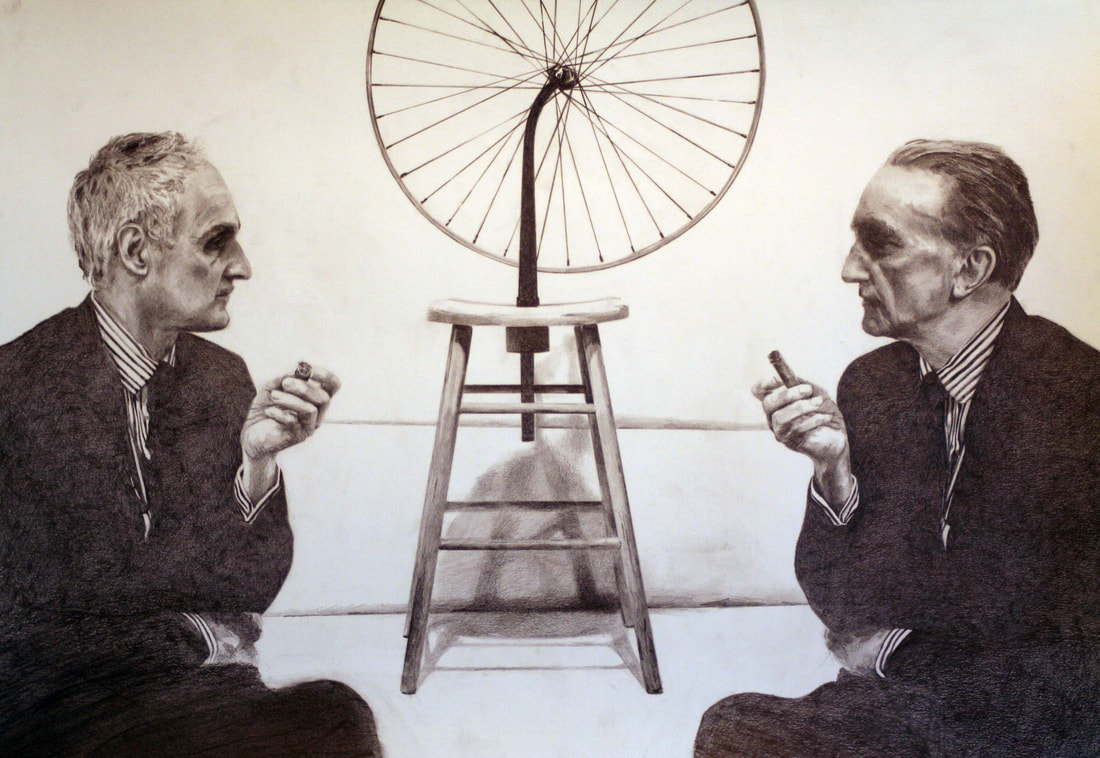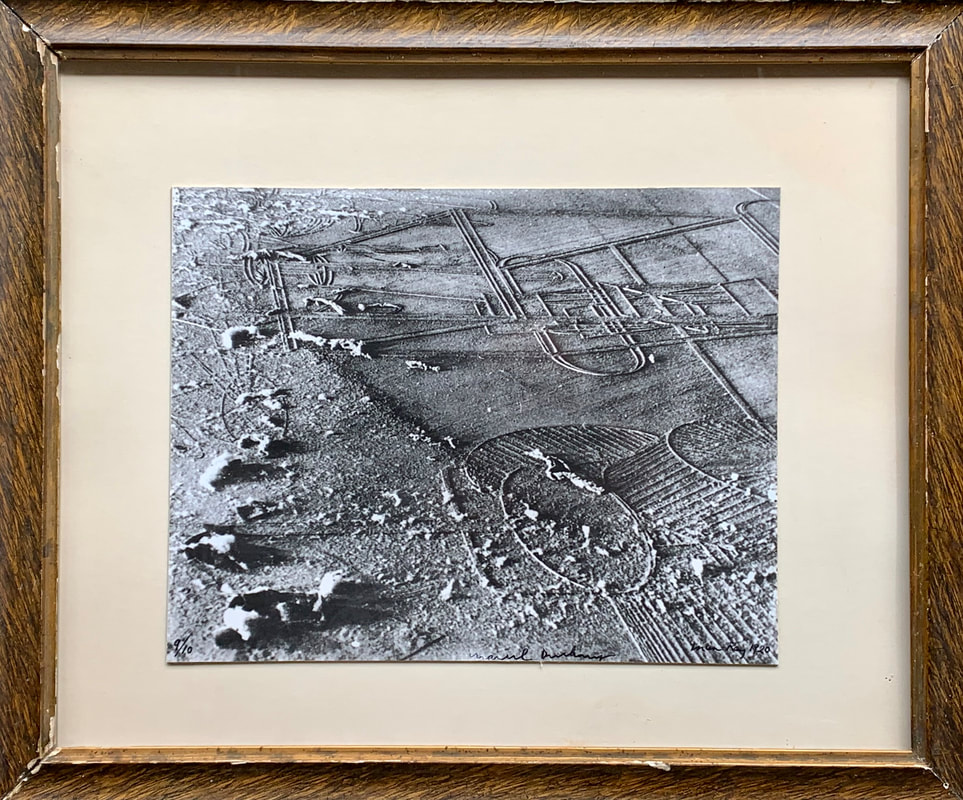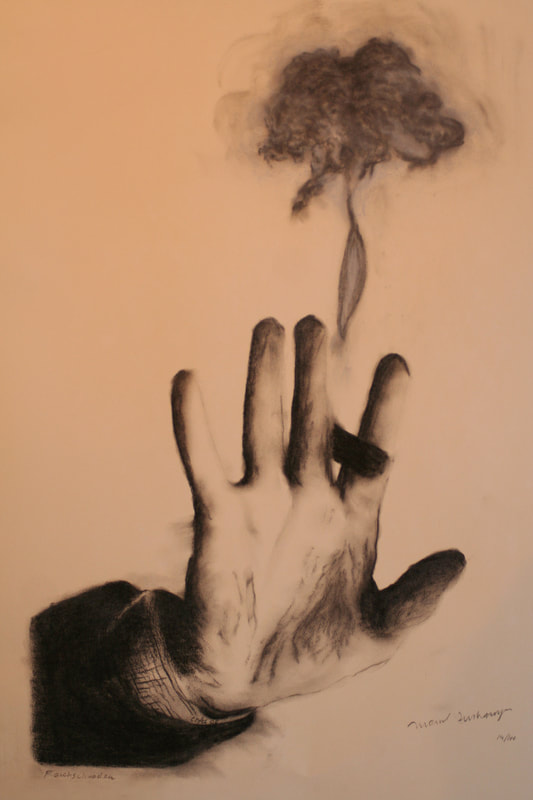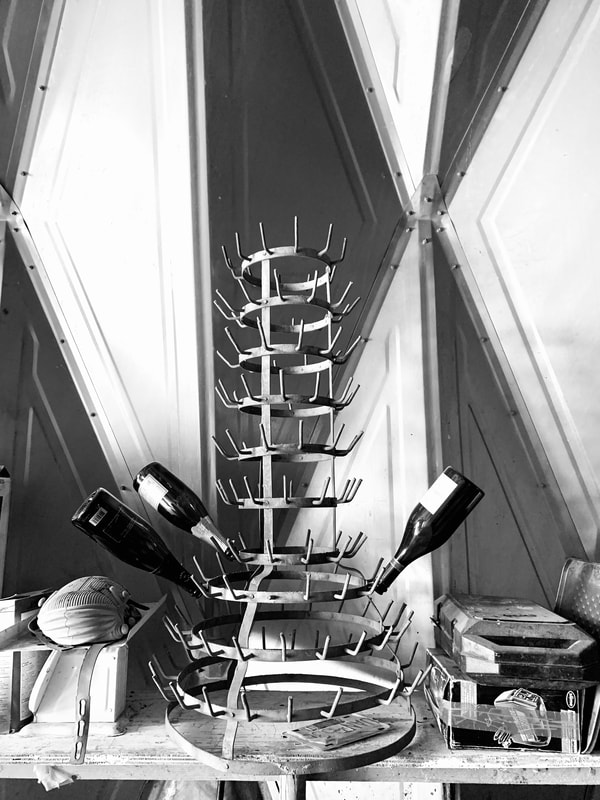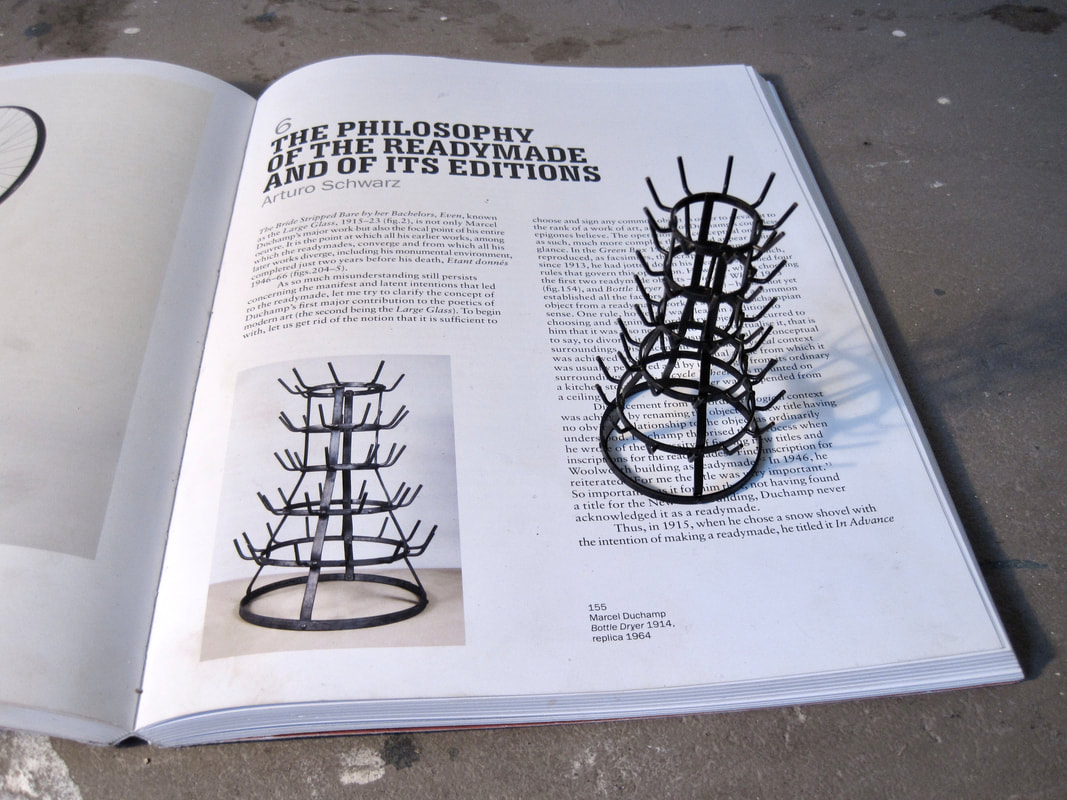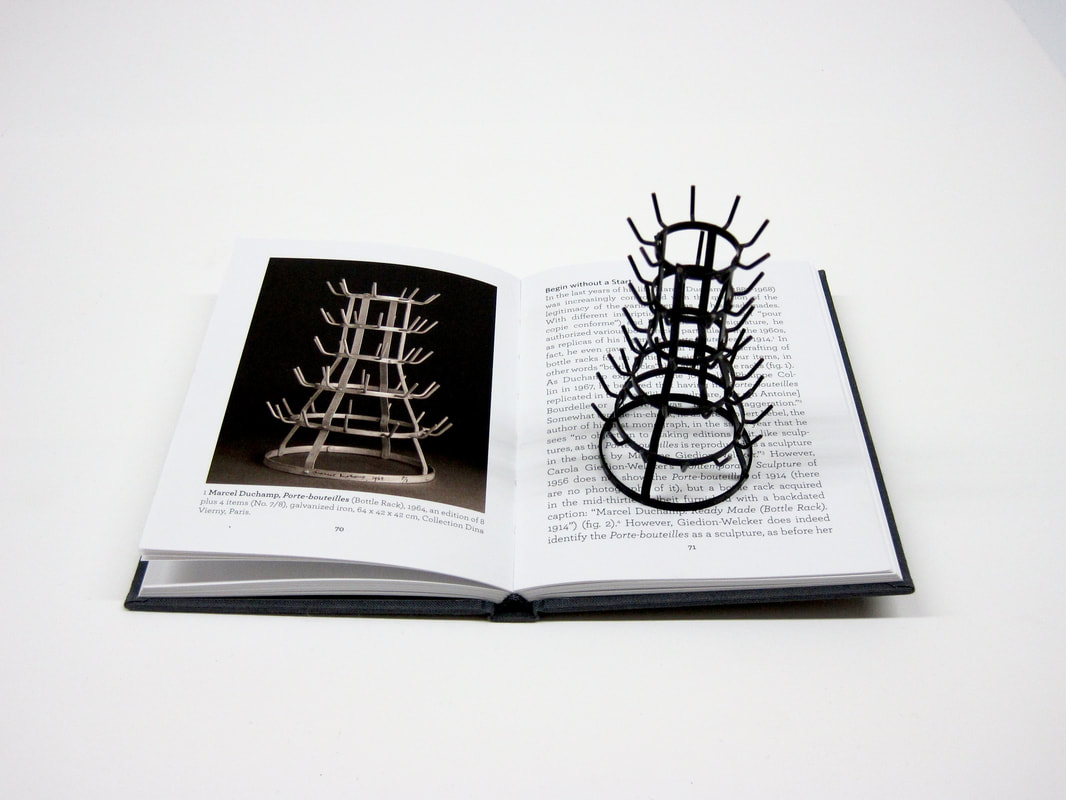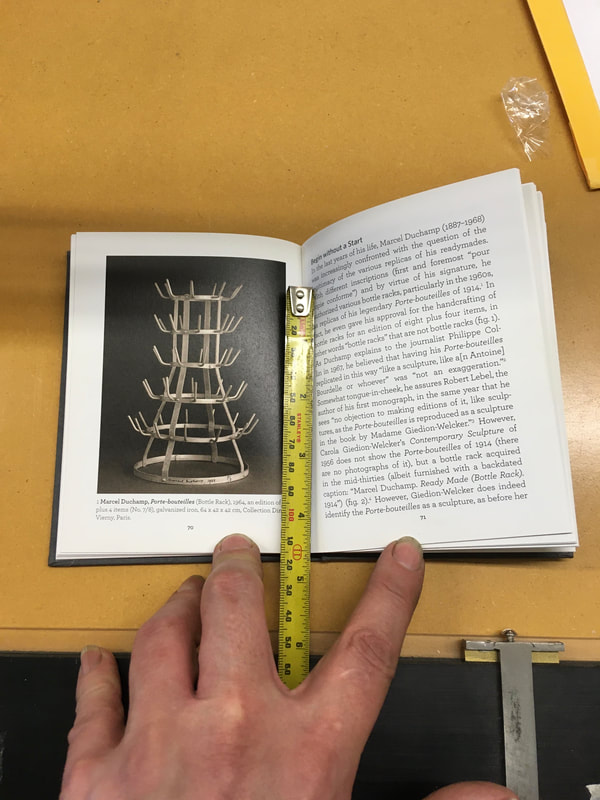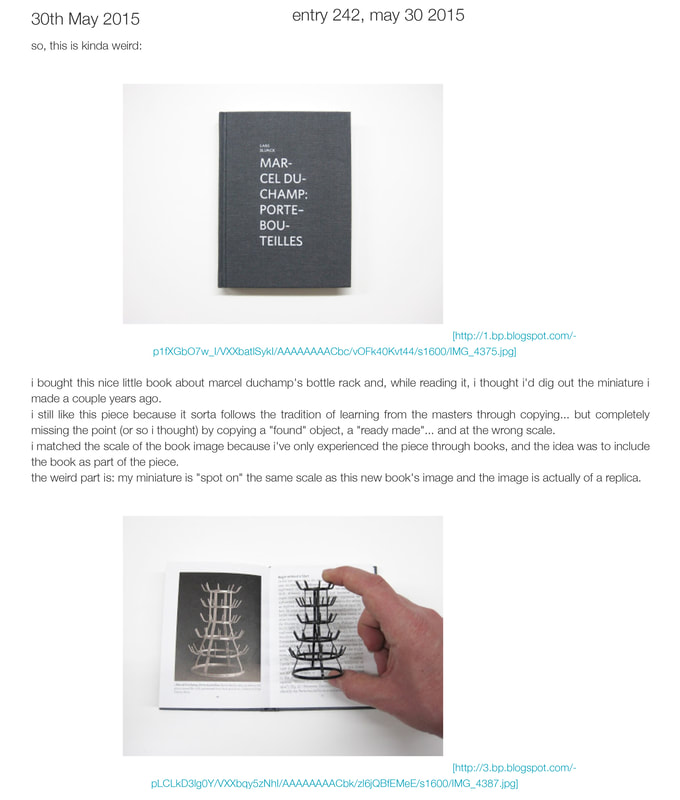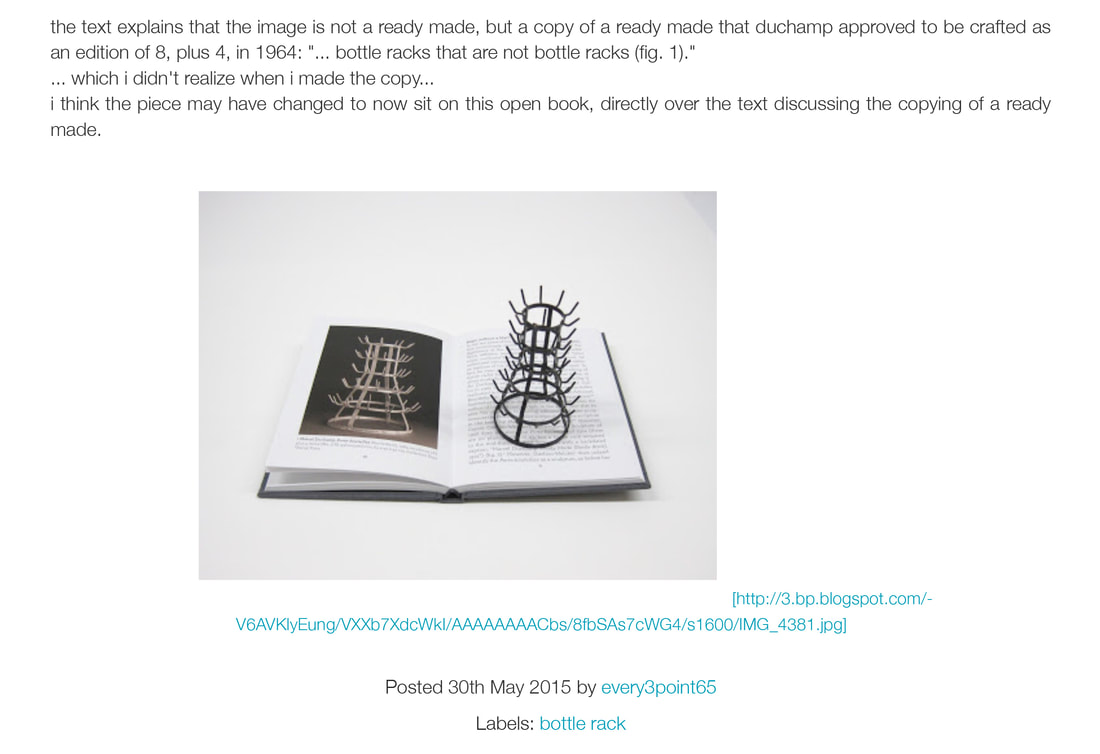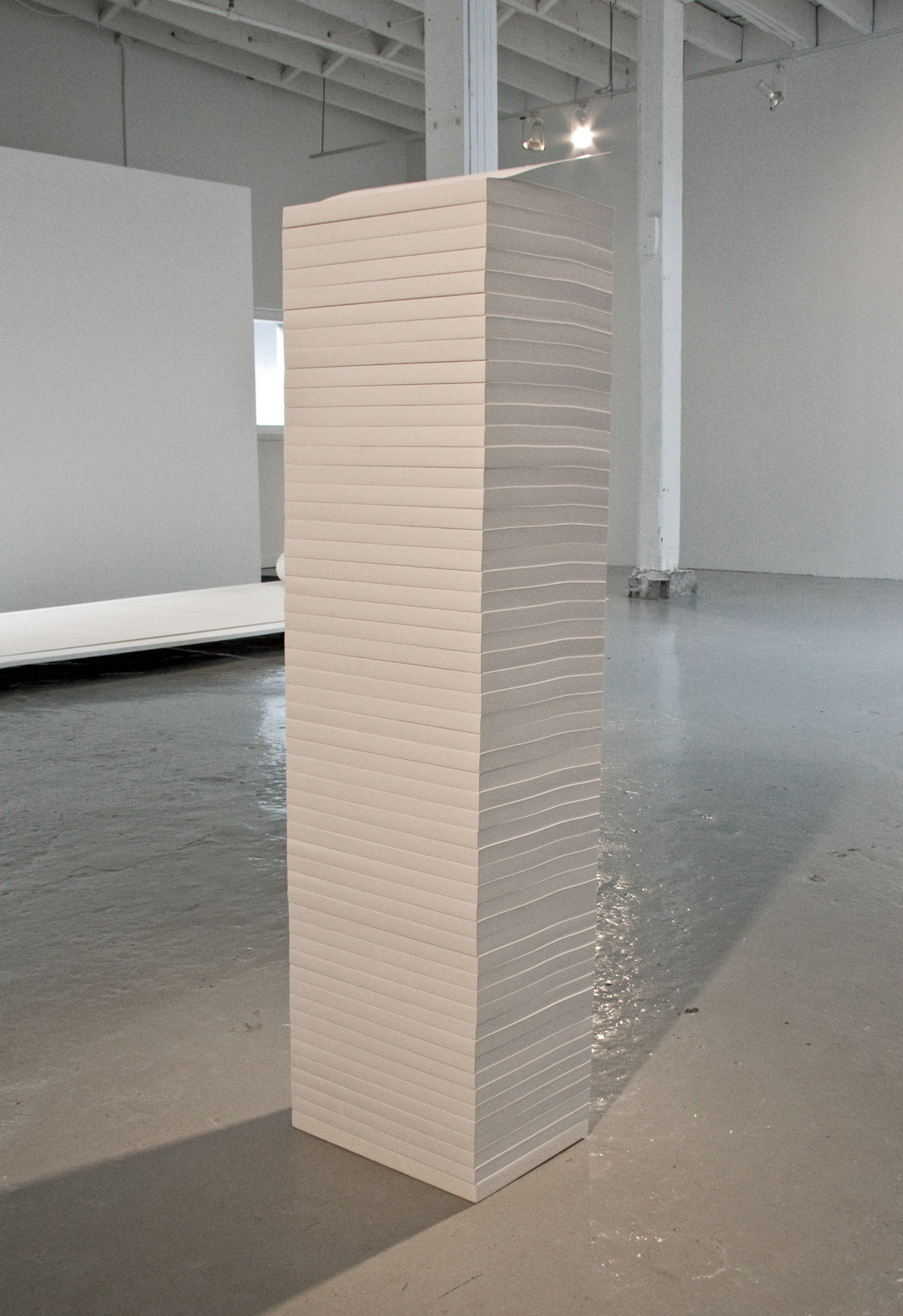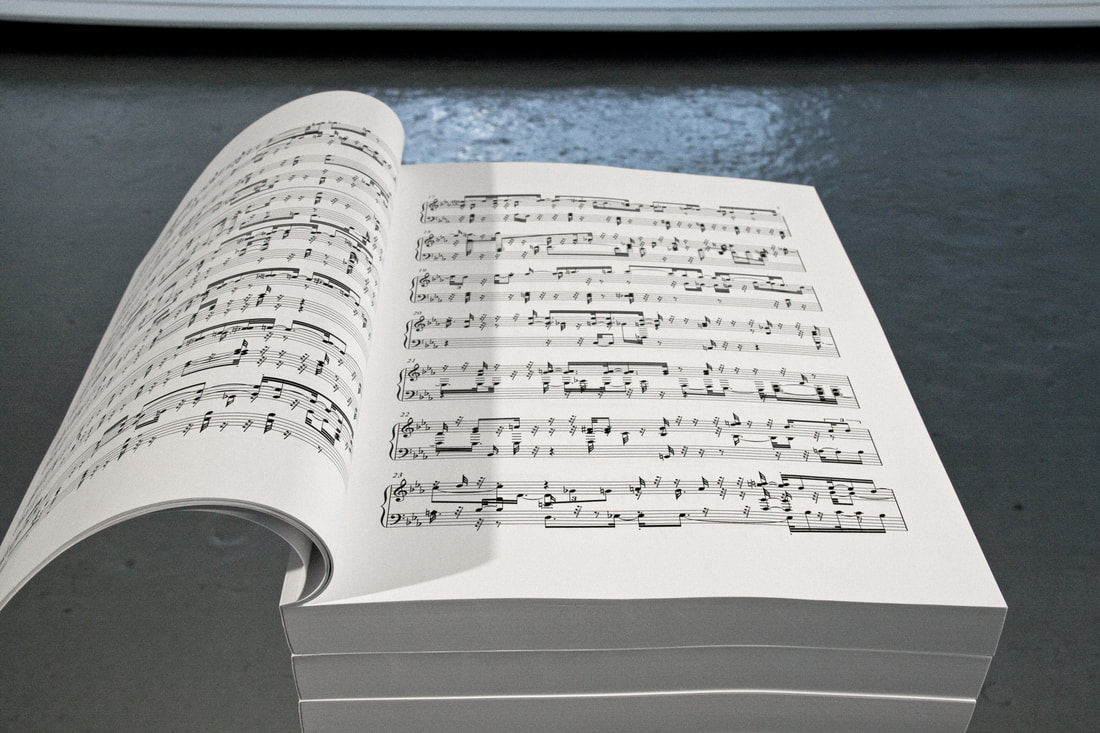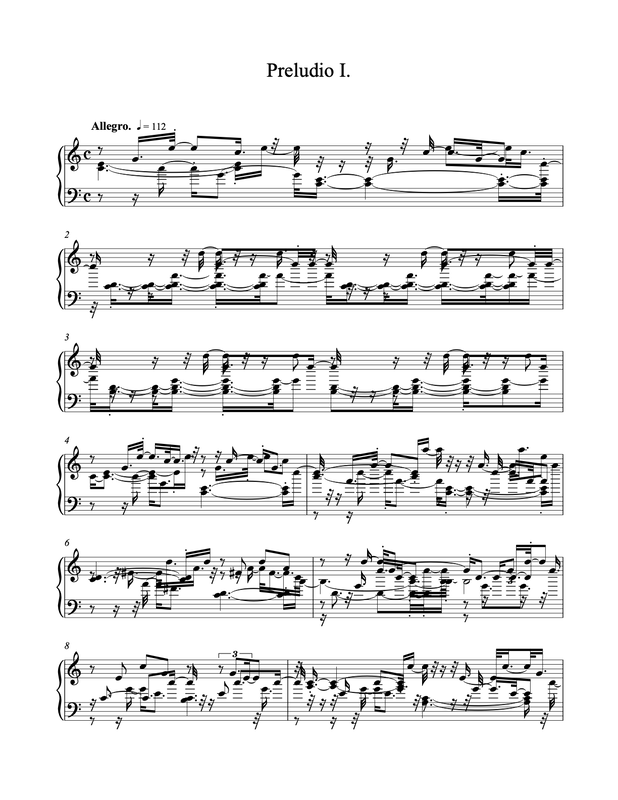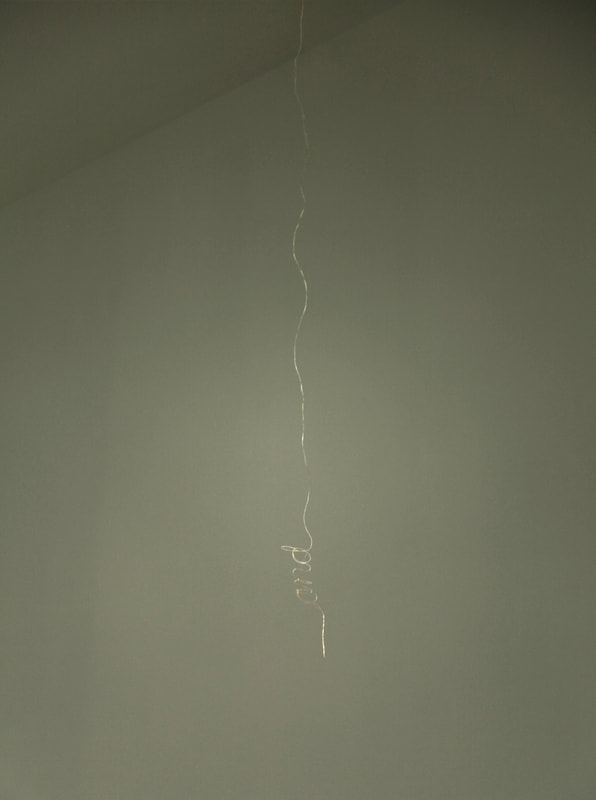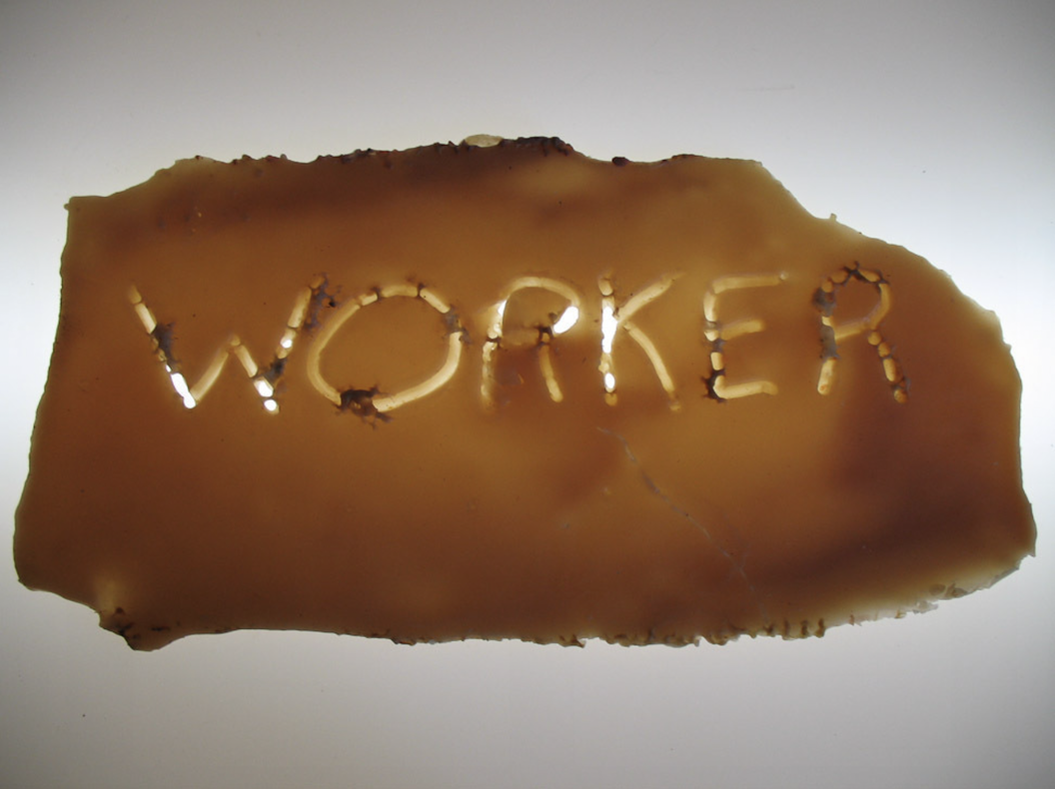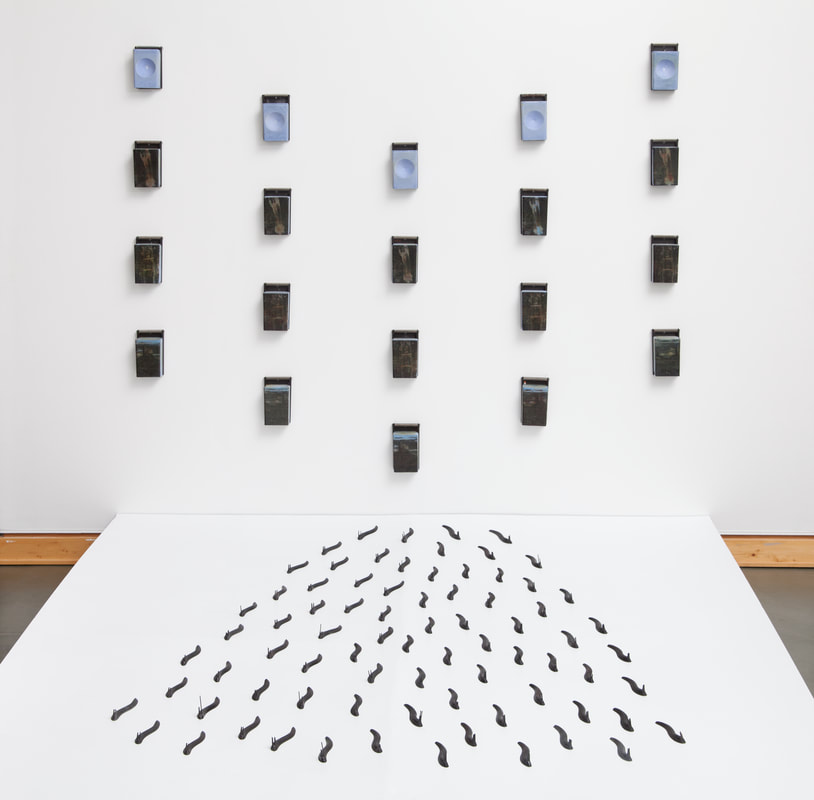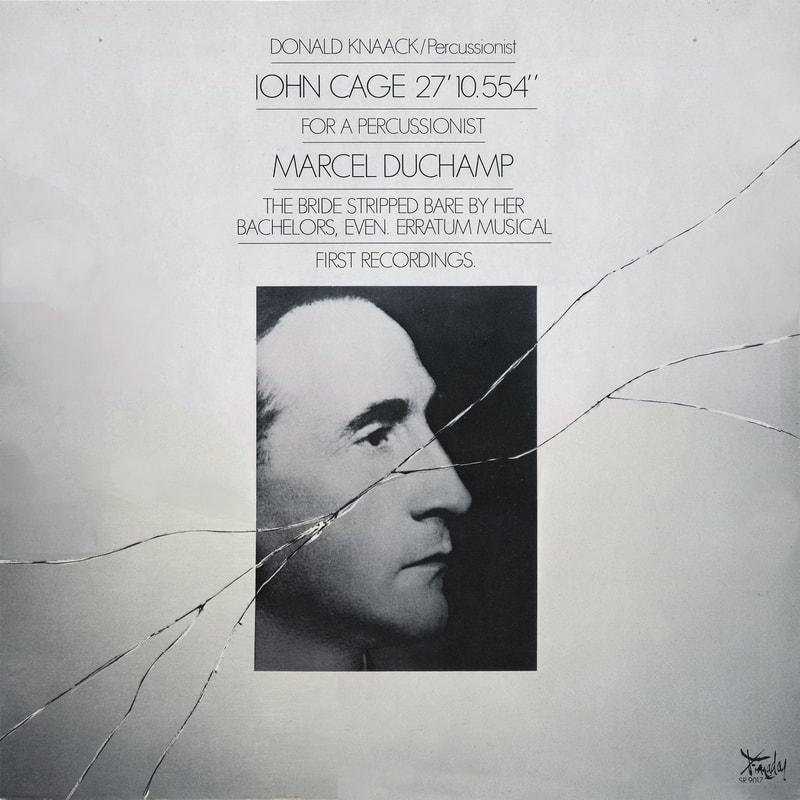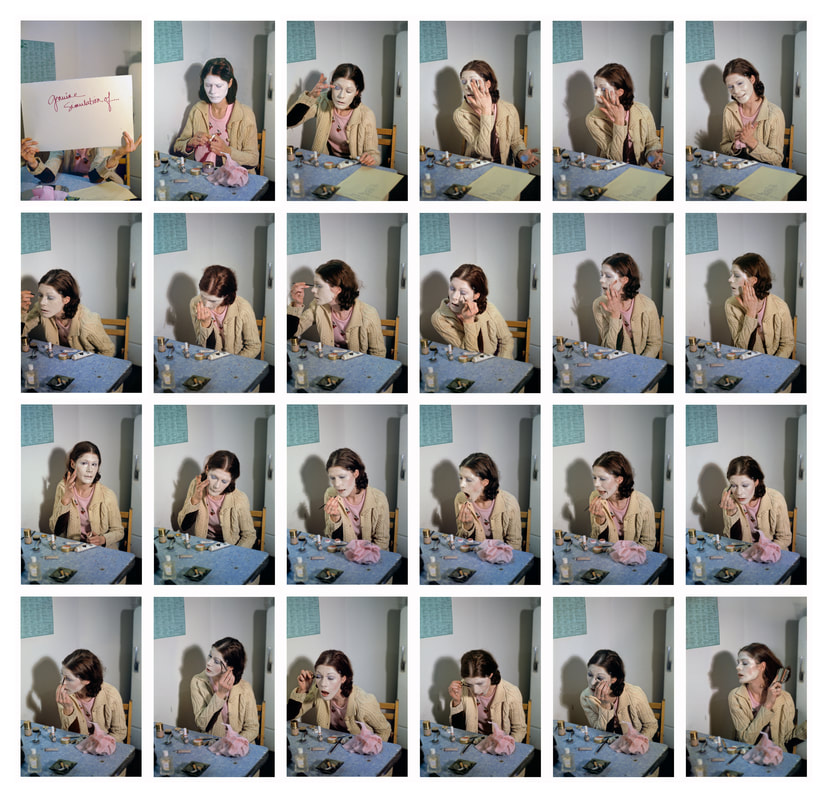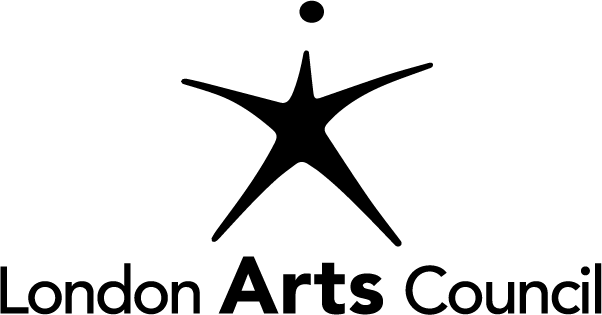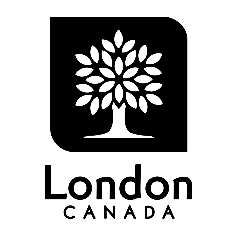W O R K S
Christine Walde
Inspired by Duchamp’s the Large Glass, Bride Machine is composed of single broadsides, transparencies, chapbooks, and other printed works. Each folio in Bride Machine is both a disruption and meditation on the act of reading, challenging readers’ assumptions about the codex and the ephemeral nature of the archive through the counter-narrative of its hinged, folded, coiled, bound and stapled elements. Part amuse-bouches, part observation, Bride Machine is also a rigorous interrogation of desire, the fourth dimension, conceptual poetics, and the emancipation of Duchamp’s Bride from her apotheosis of virginity.
Bride Machine, 2018
Edition of 10 (+2Aps). Produced in collaboration with Lynda Gammon and flask publishing, Victoria BC.
mixed media papers and printing processes
Cloth-bound clamshell folio box closed: 38.9w x 41d x 10.5h cm
Courtesy and copyright of the artist
Bride Machine, 2018
Edition of 10 (+2Aps). Produced in collaboration with Lynda Gammon and flask publishing, Victoria BC.
mixed media papers and printing processes
Cloth-bound clamshell folio box closed: 38.9w x 41d x 10.5h cm
Courtesy and copyright of the artist
Michael Snow
Waiting Room, 1979
Photograph and sculptural element in mixed media
Courtesy and copyright the artist. Images courtesy and collection, Museum London
"In Waiting Room reality is only an imploded structure, as though a camera has been set for an infinite exposure, which renders all contingencies – that is all history, all ethics, all power – irrelevant and imperceptible. This Waiting Room, it is clear, exists at the end of history, beyond anticipation, beyond form itself."
Ian Carr-Harris, guest curator for How We See What We Say, Art Gallery at Harbourfront, 1986.
Snow stated in 1984: "I make up the rules of a game, then I attempt to play it [and] if I seem to be losing, I change the rules. Beyond the rules lies radical art."
Michael Snow contributed to Robert McKaskell’s 1987 Homage to Duchamp exhibition.
Photograph and sculptural element in mixed media
Courtesy and copyright the artist. Images courtesy and collection, Museum London
"In Waiting Room reality is only an imploded structure, as though a camera has been set for an infinite exposure, which renders all contingencies – that is all history, all ethics, all power – irrelevant and imperceptible. This Waiting Room, it is clear, exists at the end of history, beyond anticipation, beyond form itself."
Ian Carr-Harris, guest curator for How We See What We Say, Art Gallery at Harbourfront, 1986.
Snow stated in 1984: "I make up the rules of a game, then I attempt to play it [and] if I seem to be losing, I change the rules. Beyond the rules lies radical art."
Michael Snow contributed to Robert McKaskell’s 1987 Homage to Duchamp exhibition.
|
|
|
Dianne Bos
|
The series was inspired by household items I found in France. The house we bought was almost fully furnished with a lot of stuff we did not want including a lot of mysterious kitchen objects and weird things in the attic. I was intrigued by the wire baskets that are quite beautiful objects on their own. I discovered through questioning local madams that each basket design was for a specific purpose, some baskets are for eggs. Some are for snails, others for garlic. And some are still a mystery. Years ago I took Pinhole photographs of the wire baskets and the complicated shadows they created. Of course they reminded me of and were influenced by Man Ray and the kind of objects he used in his Rayograms. Last year I started combining a lot of these kitchen objects together, mobile sculptures, (Duchampian) suspending them and photographing them with a pinhole camera and vintage cameras.
All works courtesy and copyright of the artist |
|
Duchamp’s Kitchen 303, 2018
Rolleicord camera negative Silver gelatin print 102 x 102 cm Duchamp’s Kitchen 016, 2018
Pinhole camera image printed as a silver gelatin print 102 x 102 cm |
Man Ray’s Buffet 1, 2019
Cyanotype Rayogram print 112 x 76cm Rayogram is a term invented by Man Ray, merging his name with “photograph” but an older, camera-less, photogram process. Objects are placed on photosensitive paper and exposed to light, and in this work using a cyanotype emulsion that turns blue when exposed. |
Duchamp's Kitchen: À Musique Secrète, (A Short Film), September 2018 - Colour, no sound, 6 seconds
Christos Dikeakos
|
C D avec M D Puis-je fumer, 2008
graphite pencil and charcoal on paper 54 x 75 cm All works courtesy and copyright of the artist The drawing is based on a Julian Wasser photograph taken at the Duchamp retrospect at the Pasadena Museum, 1963. Dikeakos has drawn himself in on the left side. Sketch for Ashberg, Monte Christos Alpha, 1995
Photographic print 50 x 12 cm Dikeakos smoked a Montecristo cigar and photographed the ash; the cigar ash as landscape, a reference to the ‘landscape’ of Man Ray’s Dust Breeding and ‘via’ Duchamp’s lifetime cigar smoking. |
Dust Breeding (Forgery), 1969
silver print (in distressed vintage frame) 27 x 35 cm This work was included in Robert McKaskell’s Homage to Duchamp exhibition in 1987. Dikeakos created this forgery while working on his MA thesis on Duchamp and Man Ray collaborations at the University of British Columbia. He re-photographed it from the reproduction in the first British edition of The Complete Works of Marcel Duchamp and went over the signatures with a marker. A collotype of Dust Breeding is included in Duchamp’s The Green Box, 1934. Dikeakos wrote : “[It] was a time of acquiring a vicarious liberal self-education. One could study art history, the old avant-garde, and …conceptual art…readings in anthropology that dealt with alternative teachings as in shamanism and mind-altering psychoactive substances.” |
|
Rauchschwaden (cloud of smoke), 2008
charcoal on paper 76 x 56 cm Based on Marcel Duchamp Poster for the “Editions et Sur Marcel Duchamp” exhibition, Galerie Givaudan, Paris, 1967 |
Not titled or printed, 2021
iPhone image Shot at Dikeakos’s farm property in Naramata. He wrote “The bottle dryer…appearing as a found ready made in a barn.” Duchamp’s Bottle Dryer is the first ‘true’ ready-made. Although Bicycle Wheel precedes it, it is a rectified ready-made. |
Ken Nicol
Bottle Dryer Book Piece Duchamp, 2011
Steel with open book
Dimensions as shown
Private collection, Calgary. Courtesy and copyright of the artist and Olga Korper Gallery.
Steel with open book
Dimensions as shown
Private collection, Calgary. Courtesy and copyright of the artist and Olga Korper Gallery.
Hyang Cho
Well-Tempered Clavier, 2012/2013
30.5 x 22.8 cm
A unique printed multiple.
Courtesy and copyright of the artist and Georgia Scherman Projects.
Hyang Cho practised and performed Bach’s preludes and fuges known as the so-titled Well-Tempered Clavier. Each performance was software transcribed as played, including error-variations, and printed in a book form. 72 versions were originally done, but the first 20 were not bound. There are 52 bound books, numbered from 21 to 75.
30.5 x 22.8 cm
A unique printed multiple.
Courtesy and copyright of the artist and Georgia Scherman Projects.
Hyang Cho practised and performed Bach’s preludes and fuges known as the so-titled Well-Tempered Clavier. Each performance was software transcribed as played, including error-variations, and printed in a book form. 72 versions were originally done, but the first 20 were not bound. There are 52 bound books, numbered from 21 to 75.
David Merritt
|
and, 2009
sisal fibre, approx. 61 x 3.5 cm Courtesy and copyright of the artist photo: Robert McNair In 2003, Merritt began exploring the idea of a contingent arrangement of disparate cultural fragments bound together through circumstance in a series of works made of sisal fibre. He began by unravelling a 32-foot length of rope (the approximate length of a human alimentary system) into what he calls a “highly variable, suspended state.” Merritt’s recent sisal rope pieces involve unraveling the individual fibres and forming some into fragments of cursive text enmeshed in a chaotic clould of fibres. The relationship in these works of image, language and the body (the reference to digestion, but also their scale in relation to the viewer and the physical labour involved in their making) appear volatile and difficult to, in a word, untangle. James Patten, from “Shim Sham, Shimmy,” for David Merritt, shim/sham/shimmy, a coproduction of Museum London, the Art Gallery of Hamilton, the MacLaren Art Centre and Art Gallery of Windsor, 2010 |
Aganetha Dyck
In 1991 Dyck found a source for making art that combined her preferred modus operandi of process and chance: the beehive. Once again it was a fortuitous event, this time a visit to an apiary to buy wax for her canning objects, that introduced her to the complex society of bees. As apiarists know, foreign objects placed in the hive are immediately covered over with wax and honeycomb structures. Dyck was struck by the bees' determination to make these unwanted objects more familiar by covering them with honeycomb, and she began putting unlikely objects into the hive to see how they would be altered. Dyck always gives credit to the bees, even calling them her collaborators, and indeed to a large extent she does give up control when she places an object in the beehive. The bees do their work in the summer months and in September she removes the objects from the hive. Once the bees are finished Dyck will not change a piece. A cool summer, for example, can completely reduce the bees' usually fanatical work habits and leave the art only minimally decorated. The bees are given the final say, and that, so to speak, suits the artist's modest manner very well.
Serena Keshavjee, excerpted from AGANETHA DYCK: Nature as Language, Gallery One One One., University of Manitoba, 2000
All works courtesy and copyright of the artist, and Michael Gibson Gallery, London ON
Serena Keshavjee, excerpted from AGANETHA DYCK: Nature as Language, Gallery One One One., University of Manitoba, 2000
All works courtesy and copyright of the artist, and Michael Gibson Gallery, London ON
Eric Robertson
|
Lick, 1997
Sculptural installation with 78 cast zinc slugs, 20 salt blocks with Xerox transfers and zinc installation dimensions, approx. D-244 x H-244 cm Courtesy of and Collection, Kelowna Art Gallery |
While Eric Robertson was living in the Okanagan and teaching visual arts at the En’okin Centre in Penticton he took note of the salt lick blocks out on the landscape, placed there for horses, and livestock. Lick stages a poetic relationship between land, culture and agriculture, and in turn the interdependency of agriculture as economy and a way of life, and a wellspring for visual and oral culture. At the same time, the work draws attention to the contradictions in life and how we live it. Salt contains nutrients that are necessary for life, but it is also a corrosive element that breaks through the protective membrane of slugs.
Some of the salt lick elements have a cored-out centre while others are covered with found images Xerox-transferred onto their surfaces. Robertson stated that the selected images “relate to erosion [the butte]; [a totem] pole in [a] state of restoration, removed from intended cultural context.” Robertson also made note of the use of salt for “preservation and conservation, [and the] salting of culture [and] identity.” The phrase ‘working in the salt mines’ refers to physically challenging and unpleasant labour. The slugs are arranged as a counterpoint to the salt lick elements – the former ‘of the earth’ and the latter mounted on the wall as an otherworldliness and ascension. The sloping plinth on which the slugs flee the salt licks is intended “to reflect [the] topography of Okanagan land erosion as one would see earth flows accumulating at the base of landslides.” Ihor Holubizky, for the Kelowna Art Gallery 2000, amended 2021 |
Lynn Dreese Breslin
|
As an art student, I studied Duchamp and frequented the Philadelphia Art Museum, often visiting the famous Bachelors Stripped Bare by Her Bachelors, Even (The Large Glass). I always loved the story about the glass being broken en route…and how Duchamp embraced this accident, this element of chance, feeling that it completed his work in a way he couldn't.
I simply decided to put a crack in the photo and album cover as though it were made of glass. My break wasn’t so accidental. Because the Finnadar album cover budgets were low, I bought three panes of glass at the local hardware store and brought my hammer to work. I needed to do some tests first, because if I hit too hard, the glass would shatter into small fragments. Too many cracks would interfere with the text and the image. On my third glass panel, I got the break I wanted. As I recall, I tried different variations of where the cracks would fall and also experimented with the scale of the photo in relation to the broken glass. Eventually, my decision was to position the crack to fall in a diagonal direction across Duchamp’s face which I had placed on, I believe, was a white background. Then, with the broken glass positioned on top of the photo, a number of photographs were taken until the right exposure without the glare of the glass was achieved. From correspondence with the artist. Lynn Breslin is an Adjunct Professor of Art & Design at Parsons the New School. |
Cover design for Donald Knaack
27' 10.554 The Bride Stripped Bare By Her Bachelors, Even. Erratum Musical. First Recordings, Finnadar Records, 1977 Courtesy and copyright of the artist |
Suzy Lake
Imitations of Myself #2, 1973/2013
chromogenic print, edition of 5
79 x 84.77 cm
Courtesy and copyright of the artist, and Georgia Scherman Projects
One impression, Collection Museum London.
“I don’t try to say what my identity is. I’m not some heroine recounting my life. I needed a constant, a vulnerable subject for a reference point. The reason I use myself as a model is because I’m always on hand, always around.”
Suzy Lake, a 1975 interview, cited in Suzy Lake (Steidel Publishers, 2016)
chromogenic print, edition of 5
79 x 84.77 cm
Courtesy and copyright of the artist, and Georgia Scherman Projects
One impression, Collection Museum London.
“I don’t try to say what my identity is. I’m not some heroine recounting my life. I needed a constant, a vulnerable subject for a reference point. The reason I use myself as a model is because I’m always on hand, always around.”
Suzy Lake, a 1975 interview, cited in Suzy Lake (Steidel Publishers, 2016)
Gary Spearin
401EXIT232: EAST AND WEST, 2018
digital print on Hahnemuhle Photo Rag Bright White 308gsm paper mounted on aluminum,
254 x 101.6 cm
Both courtesy and copyright of the artist
401EXIT232: EAST AND WEST is a montage of images of an endless stream of traffic from both east and west. Taken from the height of the overpass – the location site for Jack Chambers painting 401 London No.1, 1968-69 (Collection Art Gallery of Ontario, and based on source photographs that Chambers shot – the photos mark the importance of the 401 as the key transportation corridor across Ontario. Developed in a patchwork system since 1952 as a means to bypass Toronto, the 401 at times feels that it is bursting at its capacity. This is a very different reality than the one rendered by Chambers, that of a serene car ride towards his home in London, punctuated by rolling hills, agricultural lands, wooded lots and the odd cluster of industrial buildings.
From Mary Reid essay 401EXIT232, Coming Home, Woodstock Art Gallery, 2018
Gary Spearin undertook a campaign to place a commemorative bronze plaque near the location where Chambers shot his original study photographs.
digital print on Hahnemuhle Photo Rag Bright White 308gsm paper mounted on aluminum,
254 x 101.6 cm
Both courtesy and copyright of the artist
401EXIT232: EAST AND WEST is a montage of images of an endless stream of traffic from both east and west. Taken from the height of the overpass – the location site for Jack Chambers painting 401 London No.1, 1968-69 (Collection Art Gallery of Ontario, and based on source photographs that Chambers shot – the photos mark the importance of the 401 as the key transportation corridor across Ontario. Developed in a patchwork system since 1952 as a means to bypass Toronto, the 401 at times feels that it is bursting at its capacity. This is a very different reality than the one rendered by Chambers, that of a serene car ride towards his home in London, punctuated by rolling hills, agricultural lands, wooded lots and the odd cluster of industrial buildings.
From Mary Reid essay 401EXIT232, Coming Home, Woodstock Art Gallery, 2018
Gary Spearin undertook a campaign to place a commemorative bronze plaque near the location where Chambers shot his original study photographs.
CAMEO APPEARANCES, 2021
digital photography, variable size
What cycles before, discarded, fragmented, recycled, constructs a conglomerate of its own nature. In camera, submerged ghost migrations appear, disappear, re-appear, shuffling into an image.
- Gary Spearin
digital photography, variable size
What cycles before, discarded, fragmented, recycled, constructs a conglomerate of its own nature. In camera, submerged ghost migrations appear, disappear, re-appear, shuffling into an image.
- Gary Spearin
